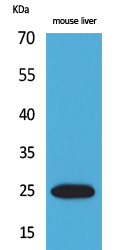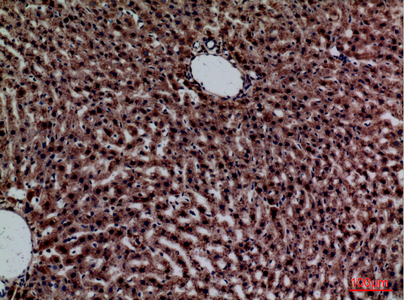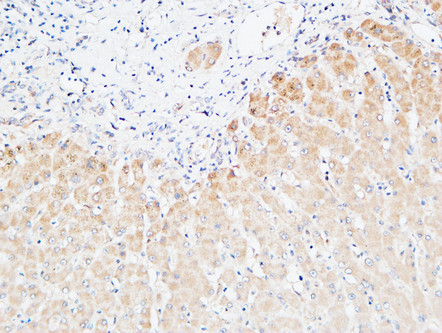CRP Polyclonal Antibody
- Catalog No.:YT5196
- Applications:WB;IHC;IF;ELISA
- Reactivity:Human;Rat
- Target:
- CRP
- Gene Name:
- CRP
- Protein Name:
- C-reactive protein
- Human Gene Id:
- 1401
- Human Swiss Prot No:
- P02741
- Mouse Swiss Prot No:
- P14847
- Rat Gene Id:
- 25419
- Rat Swiss Prot No:
- P48199
- Immunogen:
- The antiserum was produced against synthesized peptide derived from the Internal region of human CRP. AA range:101-150
- Specificity:
- CRP Polyclonal Antibody detects endogenous levels of CRP protein.
- Formulation:
- Liquid in PBS containing 50% glycerol, 0.5% BSA and 0.02% sodium azide.
- Source:
- Polyclonal, Rabbit,IgG
- Dilution:
- WB 1:500 - 1:2000. IHC: 1:100-300 ELISA: 1:20000.. IF 1:50-200
- Purification:
- The antibody was affinity-purified from rabbit antiserum by affinity-chromatography using epitope-specific immunogen.
- Concentration:
- 1 mg/ml
- Storage Stability:
- -15°C to -25°C/1 year(Do not lower than -25°C)
- Other Name:
- CRP;PTX1;C-reactive protein
- Observed Band(KD):
- 25kD
- Background:
- C-reactive protein(CRP) Homo sapiens The protein encoded by this gene belongs to the pentaxin family. It is involved in several host defense related functions based on its ability to recognize foreign pathogens and damaged cells of the host and to initiate their elimination by interacting with humoral and cellular effector systems in the blood. Consequently, the level of this protein in plasma increases greatly during acute phase response to tissue injury, infection, or other inflammatory stimuli. [provided by RefSeq, Sep 2009],
- Function:
- cofactor:Binds 2 calcium ions per subunit.,function:Displays several functions associated with host defense: it promotes agglutination, bacterial capsular swelling, phagocytosis and complement fixation through its calcium-dependent binding to phosphorylcholine. Can interact with DNA and histones and may scavenge nuclear material released from damaged circulating cells.,induction:The concentration of CRP in plasma increases greatly during acute phase response to tissue injury, infection or other inflammatory stimuli. It is induced by IL-1 and IL-6.,mass spectrometry: Ref.14,miscellaneous:This protein owes its name to its ability precipitate pneumococcal C-polysaccharide in the presence of calcium.,online information:C-reactive protein entry,online information:No more Christmas pudding? - Issue 30 of January 2003,similarity:Belongs to the pentaxin family.,similarity:Contains 1 pentaxin dom
- Subcellular Location:
- Secreted.
- Expression:
- Found in plasma.
- June 19-2018
- WESTERN IMMUNOBLOTTING PROTOCOL
- June 19-2018
- IMMUNOHISTOCHEMISTRY-PARAFFIN PROTOCOL
- June 19-2018
- IMMUNOFLUORESCENCE PROTOCOL
- September 08-2020
- FLOW-CYTOMEYRT-PROTOCOL
- May 20-2022
- Cell-Based ELISA│解您多样本WB检测之困扰
- July 13-2018
- CELL-BASED-ELISA-PROTOCOL-FOR-ACETYL-PROTEIN
- July 13-2018
- CELL-BASED-ELISA-PROTOCOL-FOR-PHOSPHO-PROTEIN
- July 13-2018
- Antibody-FAQs
- Products Images

- Western Blot analysis of mouse liver cells using CRP Polyclonal Antibody. Secondary antibody(catalog#:RS0002) was diluted at 1:20000
.jpg)
- Immunohistochemical analysis of paraffin-embedded rat-liver, antibody was diluted at 1:100

- Immunohistochemical analysis of paraffin-embedded rat-liver, antibody was diluted at 1:100

- Immunohistochemical analysis of paraffin-embedded Human Liver. 1, Antibody was diluted at 1:200(4° overnight). 2, High-pressure and temperature EDTA, pH8.0 was used for antigen retrieval. 3,Secondary antibody was diluted at 1:200(room temperature, 30min).

- Western blot analysis of lysate from mouse liver cells, using CRP Antibody.



